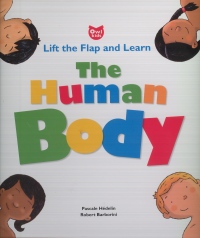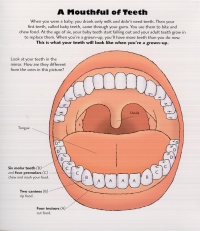| ________________
CM . . . . Volume XVIII Number 3 . . . . September 16, 2011

 |
The Human Body: Lift the Flap and Learn.
Pascale Hédelin. Illustrated by Robert Barborini. Translated by Katherine Dearlove.
Toronto, ON: Owl Kids, 2011.
38 pp., hardcover spiral bound, $27.95.
ISBN 978-1-897349-86-1.
Subject Headings:
Human body-Juvenile literature.
Human physiology-Juvenile literature.
Human anatomy-Juvenile literature.
Lift-the-flap books.
Preschool-grade 3 / Ages 4-8.
Review by Dave Jenkinson.
*** /4
|
| |
|

Originally published in France as Le grand livre animé du corps humain, The Human Body takes young readers on a “body” journey, beginning with conception and birth.  Each pair of facing pages functions as a form of chapter, with the topics being growth, muscles, bones, circulatory system, lungs, digestive system, brain, the senses, and illnesses and the body. “Skin”, the closing portion of the book, includes separate frontal drawings of a naked prepubescent girl and a boy (yes, they are anatomically correct genitally speaking), and these two body outlines can be “flipped” to reveal the skeleton, body parts, the respiratory system, the circulatory system, major muscle groups, and the digestive system, all labeled. The Human Body is generously illustrated with Robert Barborini’s artwork that reflects a multicultural world. Pascale Hédelin’s text is presented in brief, captioned blocks, and his use of pronouns is gender balanced. Each pair of facing pages functions as a form of chapter, with the topics being growth, muscles, bones, circulatory system, lungs, digestive system, brain, the senses, and illnesses and the body. “Skin”, the closing portion of the book, includes separate frontal drawings of a naked prepubescent girl and a boy (yes, they are anatomically correct genitally speaking), and these two body outlines can be “flipped” to reveal the skeleton, body parts, the respiratory system, the circulatory system, major muscle groups, and the digestive system, all labeled. The Human Body is generously illustrated with Robert Barborini’s artwork that reflects a multicultural world. Pascale Hédelin’s text is presented in brief, captioned blocks, and his use of pronouns is gender balanced.
Virtually every pair of facing pages has something that calls upon the reader to turn a wheel, lift a flap, pull, touch or push something, all actions which, when completed, then yield additional text and/or illustrated information. Fingers that do the pulling of tabs and other actions need to be sufficiently dexterous that they will not tear or otherwise damage the numerous tabs and flaps. While The Human Body has a solid wire spiral binding within sturdy covers, the interactive aspect of reading this book suggests that it might stand up better as a home purchase, especially for children who favor a kinesthetic learning style, as opposed to the book’s being a library acquisition.
The Human Body is a good introductory overview of the body, and the text is generally accessible to its intended audience. Parents and other adults who might be concerned about the book’s beginning with conception can be reassured that the book has no “bedroom” scenes. Instead, the text simply reads:
Seeds of Life
It takes a man and a woman to make a baby. The man puts a tiny seed, called a sperm, in the woman’s belly. The sperm joins with a seed from the woman, called an egg. Together, the two seeds grown into a baby. Watch the baby grown in his mommy’s belly as the months go by.
The above text is accompanied by three illustrations which invite the readers to lift a flap over a woman’s “belly”. The reader’s doing so will reveal the to-be-born infant at 2 months, 5 months and 8 months of development. [As an aside, why does Hédelin use the correct technical term “sperm” and then revert to the potentially confusing “woman’s belly”?]
Recommended.
Dave Jenkinson, CM’s editor, lives in Winnipeg, MB.

To comment
on this title or this review, send mail to cm@umanitoba.ca.
Copyright © the Manitoba Library Association. Reproduction for personal
use is permitted only if this copyright notice is maintained. Any
other reproduction is prohibited without permission.
NEXT REVIEW |
TABLE OF CONTENTS FOR THIS ISSUE
- September 16, 2011.
AUTHORS |
TITLES |
MEDIA REVIEWS |
PROFILES |
BACK ISSUES |
SEARCH |
CMARCHIVE |
HOME |

 Each pair of facing pages functions as a form of chapter, with the topics being growth, muscles, bones, circulatory system, lungs, digestive system, brain, the senses, and illnesses and the body. “Skin”, the closing portion of the book, includes separate frontal drawings of a naked prepubescent girl and a boy (yes, they are anatomically correct genitally speaking), and these two body outlines can be “flipped” to reveal the skeleton, body parts, the respiratory system, the circulatory system, major muscle groups, and the digestive system, all labeled. The Human Body is generously illustrated with Robert Barborini’s artwork that reflects a multicultural world. Pascale Hédelin’s text is presented in brief, captioned blocks, and his use of pronouns is gender balanced.
Each pair of facing pages functions as a form of chapter, with the topics being growth, muscles, bones, circulatory system, lungs, digestive system, brain, the senses, and illnesses and the body. “Skin”, the closing portion of the book, includes separate frontal drawings of a naked prepubescent girl and a boy (yes, they are anatomically correct genitally speaking), and these two body outlines can be “flipped” to reveal the skeleton, body parts, the respiratory system, the circulatory system, major muscle groups, and the digestive system, all labeled. The Human Body is generously illustrated with Robert Barborini’s artwork that reflects a multicultural world. Pascale Hédelin’s text is presented in brief, captioned blocks, and his use of pronouns is gender balanced.